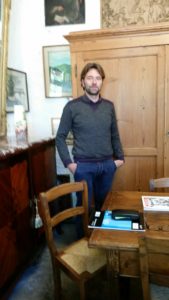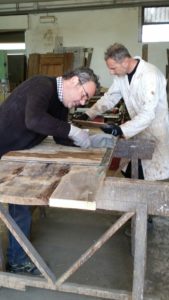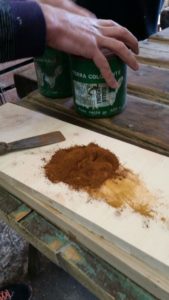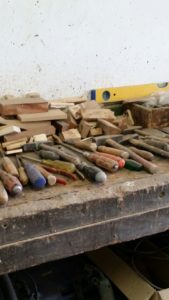For the past couple of years, I have been conducting interviews with people who live in Anghiari. Some are conducted in Italian, some in English, and they are all published in both languages on this blog. While in Anghiari in spring this year, I continued this project. Here is the first of these interviews.
Appartenenza ad Anghiari – Andrea Calli
Andrea ha 47 anni ed è vissuto tutta la sua vita ad Anghiari. Insieme al fratello Giulio continua la tradizione di famiglia di restauro del mobile. L’ho intervistato nel loro negozio che si trova ai limiti del paese, nel quartiere La Croce, che ha preso il nome dalla croce che si dice san Francesco avesse piantato proprio là. Dopo, Andrea mi ha fatto vedere la loro bottega che si trova in fondo alla strada per Tavernelle. L’intervista è stata effettuata in italiano, poi trascritta e tradotta in inglese da Mirella Alessio e la seguente ne è la versione editata.
Sono nato qui, a Anghiari, quindi un anghiarese doc, mi definisco un anghiarese doc. Sono nato, posso dire, in una bottega di un artigiano, perché il mio babbo era già un antiquario e restauratore di mobili, come mio nonno e mio zio. Sì, mio padre prima lavorava qui, in questo negozio, dove io e mio fratello, che ha due anni più di me, adesso lavoriamo.
La casa della famiglia è in Anghiari, nel centro storico, proprio nelle mura, nel castello. Io sono andato a scuola a Anghiari dove c’è l’istituto d’arte che imparano anche a lavorare il legno e poi c’è la scuola superiore di specializzazione, proprio sul restauro. In quegli anni ancora la scuola era un istituto importante, adesso un po’ ha perso il suo prestigio.
Da piccolo vedevo il mio babbo che lavorava il legno e mi piaceva quello che riusciva a recuperare, perché il nostro in pratica è un artigianato creativo sì, ma è anche di conservazione, portare avanti nel tempo dei mobili antichi, dargli la possibilità di continuare, avere la sua funzione. Non c’è nessuna decisione, ci sono nato, poi appunto la scuola vicino a casa mia insegnava questo lavoro e quindi ho continuato questa strada.
I miei genitori abitano nella casa ancora dove sono nato io, nel centro storico, sì. Molte case vengono abbandonate… Io stesso sono dovuto venire via perché fare i lavori è molto difficile, per burocrazia e altre cose. Bisogna incentivare i giovani a rimanere nel centro storico, con tutte le politiche possibili, bisogna incentivare, sennò si svuota. Mio fratello per fortuna sta ancora là, però ora la casa è un po’ troppo piccola con due bambini, speriamo decidano comunque di rimanere. Io abito fuori Anghiari, in zona Campo della Fiera, con mia moglie, Silvia, con due bambini, Francesco e Alessandro, di otto e sei anni.
Il futuro dei bambini?… Spero non in questo lavoro, perché c’è molti sacrifici da fare, perché abbiamo perso un po’, nella nostra società, la cultura dell’antichità, dell’apprezzare queste cose. Adesso molto anche per esigenze economiche, ma io penso più culturali. Ci affidiamo a grandi supermercati, a catene (non faccio nomi!) che a poco prezzo possono arredare la loro casa, quindi adesso è un po’ più difficile questo lavoro.
Anghiaresi molti pochi che comprano i nostri mobili, devo dire, molti pochi, ma questo un po’ da sempre anche quando… forse perché a Anghiari siamo anche molti antiquari. Il cliente principiale è dalla città. Per esempio, un industriale, una famiglia che compra una casa in campagna, ristruttura un casolare e allora lì piace mettere cose d’epoca. Mentre il nostro giovane che compra un appartamento ad Anghiari molto difficilmente lo arreda con mobili antichi… forse un pezzo o due lo può collocare, se magari ha una vecchia madia della nonna, allora quella la fa restaurare, sì.
Noi siamo conosciuti dappertutto in Italia, perché la famiglia Calli è stata, insieme alla famiglia Poggini, i primi antiquari, non solo in Anghiari, ma in Toscana. Abbiamo sempre venduto a Roma, Milano Napoli, in tutta Italia. Mio zio aveva clienti americani, abbiamo fatto molte spedizioni in America. E ora abbiamo clienti in Europa.
Ci sono cambiamenti, mode, ma penso che ritornerà il gusto per l’antico, perché è un valore, è una cosa importante, non può finire. Nel frattempo, noi ci adattiamo un po’ alle mode del periodo. Per esempio, magari non piace più il colore scuro del mobile, quindi noi… vede questo di legno antico scuro, un po’ rossiccio che magari non piace nell’arredamento moderno, quindi l’abbiamo gessato e dipinto di bianco, abbiamo cambiato il piano, l’abbiamo fatto di pietra serena…, diciamo che l’abbiamo reso più moderno.
Provo a spiegare in modo semplice il nostro lavoro. Il ramo principale è il restauro, il restauro vuol dire prendere un oggetto antico, vecchio che nel tempo ha subito delle rotture… I pezzi si trovano nel mercato antiquario oppure il privato, il cliente lo ha in casa sua e ce lo porta a noi a recuperare. Ecco noi lì, interveniamo, ricostruendo parti mancanti, magari con del legno antico, invece che nuovo, così non si altera la visione dell’oggetto. Una volta ricostruito, si passa alla ripulitura e poi gli facciamo una patina antica, sempre con tecniche vecchie. Magari ecco macchiamo il legno, la patina la rifacciamo con le terre, terra di Siena, usiamo della gommalacca, e poi le rifiniture normalmente sono a cera: questo è il classico restauro del mobile antico. Poi ci può essere degli interventi di “riqualifica” la chiamo io, da un frammento riscostruiamo un altro oggetto, un telaio di una porta può diventare una libreria, un mobile di una camera può diventare un mobile per un bagno, una base per un lavandino… varie trasformazioni del mobile. Dopo facciamo degli interventi di ristrutturazione dei soffitti, con tecniche moderne, sulle travi. Il mobile cucina no, falegnameria non la facciamo. Più un oggetto, un frammento, ci progettiamo, ci costruiamo qualcosa, che può essere un piccolo mobile per la cucina oppure una libreria per un salotto, una testata per un letto con un frammento… questo sì.
C’è stato un periodo, dove c’era molta crisi, non solo Anghiari, ma in tutta Italia, economica, devo dire che gli stranieri ci hanno aiutato molto a noi, nel nostro settore perché hanno comprato case, hanno ristrutturato e quindi di conseguenza le nostre ditte di Anghiari hanno lavorato. Infatti una realtà come Anghiari sente molto meno la crisi economica europea, mondiale, abbiamo questa fortuna. Faccio, un esempio: Città di Castello, c’è stato un boom sul restauro del mobile, vengono aperte molte ditte, 60- 100 ditte, 20-30 anni fa. Arrivata la crisi a Città di Castello, grande città, non vocata al turismo come Anghiari, sono chiuse quasi tutte. In Anghiari invece ci siamo un po’ salvati.
Lo straniero un po’ ha salvato Anghiari. Ma non vorrei che diventasse Anghiari una città tipo Cortona, solo di turisti. Perché solo il turismo, potrebbe sciupare il nostro paese che è rimasto come, non nel medioevo, però ha questo sapore di medioevo. È importante che il paese viva ancora di rapporti tra i cittadini, se fosse solo zona di vacanze, che d’inverno si svuota, non va bene.
Gli stranieri che vengono qui si sono anche integrati bene, noi siamo una popolazione abbastanza vivace. Non tutti la pensano come me, c’è chi non piace che d’estate ci sia dei concerti tipo Southbank, pensano loro che dia fastidio il rumore, vogliono dormire, vogliono stare in pace, però è limitato questo pensiero, comunque sia non è il mio.
Cosa c’è di speciale in Anghiari? È il mio paese natale, ha tutto di speciale, ci sono nato qui, sono particolarmente legato, qui c’è poco da dire, è la mia vita. Non è che non sono mai uscito da Anghiari… mi piace proprio la vivibilità del paese, il modo di vivere che è tranquillo, non quella corsa frenetica che troviamo nelle città.
Devo dire che ho avuto la fortuna di avere dei genitori che mi hanno portato in giro per tutta Europa, le città più importanti e meno importanti ne ho viste molte. Siamo stati a Monaco, Parigi, Amsterdam, un po’ in tutta Europa, in Normandia, sempre seguiti a un filo di arte. Fin da piccolo i miei genitori mi hanno portato in montagna, nel nord Italia più che al mare. Mi piace ancora andare in montagna, anche se mi piace anche andare al mare. Adesso viaggiamo un po’ meno, perché ci sono i bambini, un po’ per ristrettezze economiche, ce la caviamo, qualcosa facciamo magari in Italia, Roma, varie città Venezia. Ci interessano i monumenti, architettura, l’arte.
Il legame con Anghiari è forte, è stretto, di sangue, così come ho un legame molto stretto con questo lavoro, anche questo è un legame. Mio nonno mi diceva sempre che “abbiamo allevato i nostri figli in un cassetto di un comò”. Adesso noi abbiamo le carrozzine, ma loro aprivano un cassetto della camera da letto e mettevano il bambino dentro il cassetto con una coperta, come in una culla. Noi conosciamo il mobile fin dalla nascita.
Belonging in Anghiari – Andrea Calli
Andrea is 47 and has lived all his life in Anghiari. With his brother, Giulio, he is continuing the family tradition of furniture restoration. I interviewed him in their showroom which is located on the edge of town, in the quarter known as La Croce (named after the cross that San Francesco is said to have planted there). Afterwards, Andrea showed me their workshop which is down the road towards Tavernelle. The interview was conducted in Italian, and transcribed and translated into English by Mirella Alessio. This is an edited version.
I was born here, in Anghiari, so I am a genuine Anghiarese – I call myself ‘an Anghiarese DOC’. I was born, I can say, in an artisan workshop, because my father was an antiquarian and a furniture restorer, as were my grandfather and uncle. Yes, my father worked here, in this shop, where my brother (who is 2 years older than me) and I now work.
The family house is in Anghiari, in the historical centre, within the city walls, in the citadel. I went to school in Anghiari, to the art institute, where they taught woodworking and specialized in restoration. In those years the school was an important institute; now it has lost some of its prestige.
As a child, I saw my father doing woodwork and I liked what he managed to rescue, because basically what we do is, yes, creative handicraft, but it is also conservation, giving a new life to old furniture, giving furniture the possibility to continue having a use. There wasn’t any decision, I was born into it. Then, in the school near home they taught this job and so I continued on this path.
My parents still live in the house where I was born, in the historical centre. Many houses there are abandoned… I myself had to leave because renovating is very difficult, because of the bureaucracy and other things. It was simpler to move out of the historical centre. We must encourage young people to remain in the centre, with all possible policies; we must give them incentives to stay, otherwise it will be empty. Luckily, my brother still lives there, but now the house is too small, with 2 kids. We hope that they decide to stay. I live outside Anghiari, at Campo della Fiera, with my wife, Silvia, and our 2 children, Francesco and Alessandro, 8 and 6 years old.
The children’s future? … I hope it will not be in this job, because you have to make a lot of sacrifices – in part, this is because our society has lost the culture of antiquity, the appreciation of these things. And, now also for economic reasons, but I think it’s more a cultural issue. We rely on supermarkets, chain stores (no names!) where people can furnish the house cheaply, so now this job is more difficult.
Very few Anghiaresi, I must say, buy our furniture, but, in a way, it has always been like this, even when … perhaps because there were many antiquarians in Anghiari. Our customers primarily come from the cities. For example, an industrialist’s family buys a farmhouse in the countryside, they renovate it and they like to have period pieces. On the other hand, a local youngster who buys an apartment in Anghiari rarely will furnish it with antiques … perhaps they might add one or two pieces; if they have an old kitchen chest belonging to their grandmother, then they might have that restored, yes.
We are known all over Italy, because the Calli family, together with the Poggini family, we were the first antique dealers, not only in Anghiari, but in Tuscany. We have always sold our furniture in Rome, Milan, Naples, all over Italy. My uncle also had American clients, we made many shipments to America. And now, we have clients elsewhere in Europe.
There are changes, passing fashions, but I think that the appreciation of the antique will come back, because it is something to be valued, it is an important thing, it can’t end. In the meantime, we adapt a little to the fashion of the time. For example, dark coloured furniture is not popular anymore, so we …. see this old wood, dark, a bit reddish, that perhaps wouldn’t fit anymore in a modern house, we have plastered it and then painted it white, we have changed the surface and put on a top of pietra serena, sandstone… let’s say, we have made it more modern.
I’ll try to explain our work as simply as I can. Our main activity is restoration, which means taking an old object which, with time, has been damaged…. Objects come from antiquarian markets, or a private client might have it at their house and will bring it to us to restore. We rebuild the missing parts, using old wood, rather than new, so the final look of the object is not altered. Once it is rebuilt, we clean it and then we give it an old patina, always with traditional techniques. We might stain the wood, we make the patina with earth pigments such as terra di Siena, we use French polish and then we finish it with wax: this is the classical restoration of old furniture.
Then there could be other interventions, what I call ‘requalification’: perhaps the piece is too damaged, it is a fragment, and from this fragment we can rebuild another object, a door frame can become a bookcase, a piece for a bedroom can become a cabinet for a bathroom, a closet under the sink … many transformations are possible. We also restore ceilings, beams, with modern techniques. We don’t make kitchen furniture, we don’t do carpentry. We make objects from fragments, we design a new piece, we make something, it could be a small cabinet for the kitchen or a bookcase for a living room, the headboard for a bed, with a fragment … things like this.
There was a time when there was a big economic crisis, not only in Anghiari, but all over Italy, and I must say that foreigners helped our sector a lot, because they bought houses, they renovated them and then our workshops in Anghiari worked a lot. Actually, here in Anghiari, luckily, we have felt the European and global economic crises less. Here is an example: in Città di Castello there was a boom in restoration of furniture 20-30 years ago, and 60-100 firms were opened. When the crisis arrived in Città di Castello, a big town which doesn’t have a a tourist vocation like Anghiari, nearly all those firms closed down. In Anghiari we survived a bit better.
So, in a way, foreigners have saved Anghiari. But I wouldn’t like it to become a city like Cortona, with only tourists. If all we had was tourism it could ruin our town, which has this medieval flavour (but that doesn’t mean we’re living in the Middle Ages!). It is important that the town continues to live through the relationships between citizens. If it were just a holiday place, empty in winter, it wouldn’t be good.
The foreigners who do come here are well integrated; we are a very vivacious population. Not everybody thinks like me, some don’t like it that in summer there are concerts, like the Southbank Sinfonia; they are irritated by the noise, they want to sleep, be left in peace, but this way of thinking is limited – anyway this is not the way I think.
What is special about Anghiari? This is my hometown, everything is special, I was born here, I have a special bond; there is little to say about this, it is my life. It is not that I haven’t ever stepped out of Anghiari …. I like the fact that this is a liveable place; the way of life is relaxed, not that frenetic rush one finds in cities.
I must say I had the good fortune to have parents who took me around the whole of Europe, the most important cities, and also some of the less important ones. I have seen many. We went to Monaco, Paris, Amsterdam, all over Europe, to Normandy, always following the art thread. They also took us on holidays in the mountains, in northern Italy, more so than holidays at the seaside. I still really like going to the mountains, even if I also like going to the beach. For financial reasons, now with the children, we travel less, but we still manage to do something, perhaps in Italy, always Rome, other cities, Venice. We are interested in art, monuments, architecture.
It is a strong bond, a blood bond that I have with Anghiari, just as I have a very strong bond with this job – this is also a bond. My grandfather always said to me ‘we raised our children in a drawer, our cradle was a drawer of a dresser’. Now we have prams, then they opened a drawer in the bedroom and put the baby inside the drawer with a blanket, like in a cradle. So, we know furniture from birth.
Ann and Mirella


